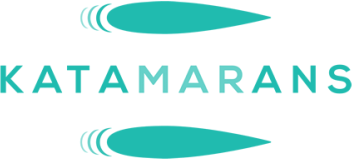Best Sailing Helm Positions – The Ultimate Guide for Catamarans!
Choosing the right helm position on a catamaran is one of the key decisions you’ll have to make for optimal sailing performance, comfort, and safety.
Each helm configuration offers unique advantages and drawbacks, influencing factors such as visibility, protection from the elements, sail handling, and crew interaction.
In this comprehensive guide, we’ll explore various helm positions, their pros and cons, and provide examples of catamarans that utilize each design.
Factors to Consider in Helm Positioning
When evaluating helm positions, consider the following aspects:
- Visibility: Ability to see forward, aft, and the sails clearly.
- Sail Handling: Ease of accessing and managing sail controls.
- Protection from Elements: Exposure to wind, rain, and sun.
- Crew Interaction: Communication and proximity to guests and crew members.
- Boat Performance: Impact on weight distribution and sailing dynamics.
Types of Helm Positions
1. Single Raised Mid Helm
Pros:
Elevated position offers excellent forward visibility.
Central location means you can dock and anchor easily
Reasonably protected, especially with a hard bimini and clears
Cons:
More difficult to trim your sails on one tack.
Can be exposed to the weather from the side.
Example: Lagoon 43
The Lagoon 43 features a single raised helm on the starboard side, providing a commanding view and centralised sail controls.
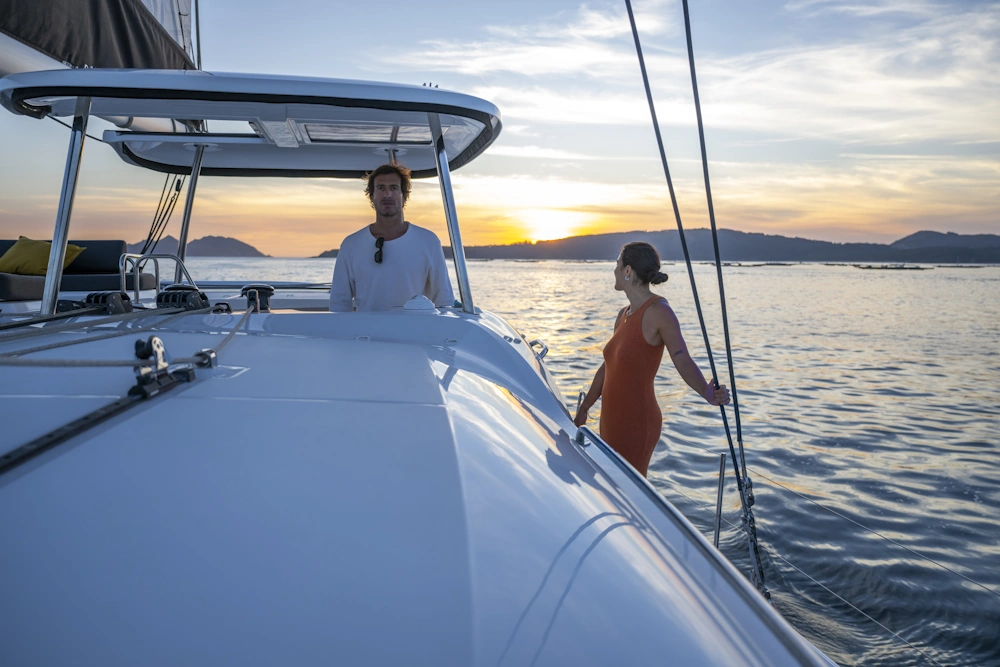
2. Twin Raised Mid Helms
Pros:
Dual helms offer optimal visibility on both tacks, great for trimming your sails
Enhances performance sailing with better weight distribution.
Cons:
Duplicated equipment adds to maintenance and cost.
Uses up more living space in the aft cockpit.
Example: HH50
The HH50 is designed with twin raised helms, emphasizing performance and control for the discerning sailor.
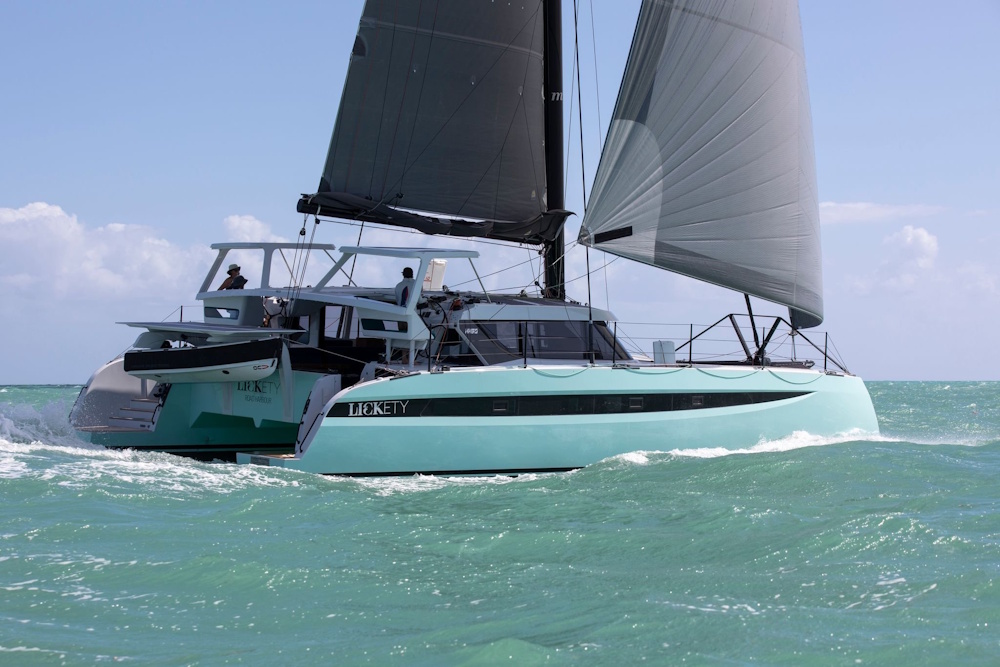
3. Central Mid Helm
You don’t see this type of helm position much on newer designs. It suits smaller vessels.
Pros:
Offers protection from elements and good visibility all round.
Central position allows easy access to both sides of the vessel.
Cons:
Reduces space in the main cockpit area.
Example: Catana 381
The Catana 381’s central mid helm combines safety and performance, situated for optimal sail management.
4. Twin Aft Helms
Pros:
Provides an unobstructed view of your sails on both tacks.
Enhanced sailing feel with direct rudder feedback and the wind in your hair.
Easy to dock, you can helm and throw the lines yourself.
Good visibility forward of the crew.
You can set the boom low which makes for a seaworthy boat
Maximise your solar on the cabin top.
Cons:
Exposed to the weather, some designs have helm biminis.
Distance from the bow can mean anchoring is more difficult.
Reduced visibility to the opposite bow, you may need to switch sides every now and then.
Example: Nautitech 48 Open
Featuring twin aft helms, the Nautitech 48 Open offers a sporty sailing experience with good visibility of the sails on both tacks.
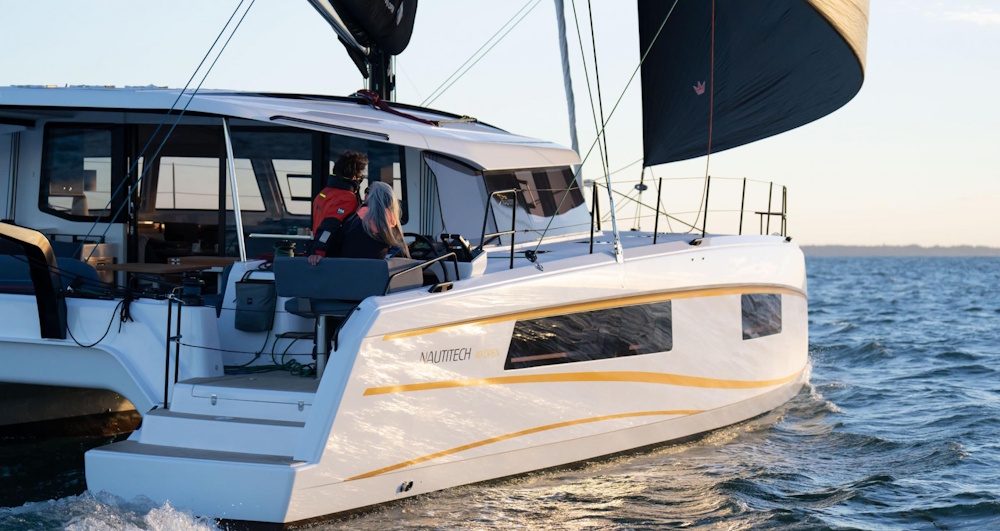
5. Forward Outside Helm
Pros:
Excellent forward visibility, ideal for collision avoidance
Proximity to the mast simplifies sail adjustments.
Cons:
Exposed to weather conditions, increasing crew fatigue.
Distance from the cockpit can hinder social interaction and communication.
Example: Atlantic 57
The Atlantic 57 places the helm forward, catering to sailors seeking performance and direct sail management.
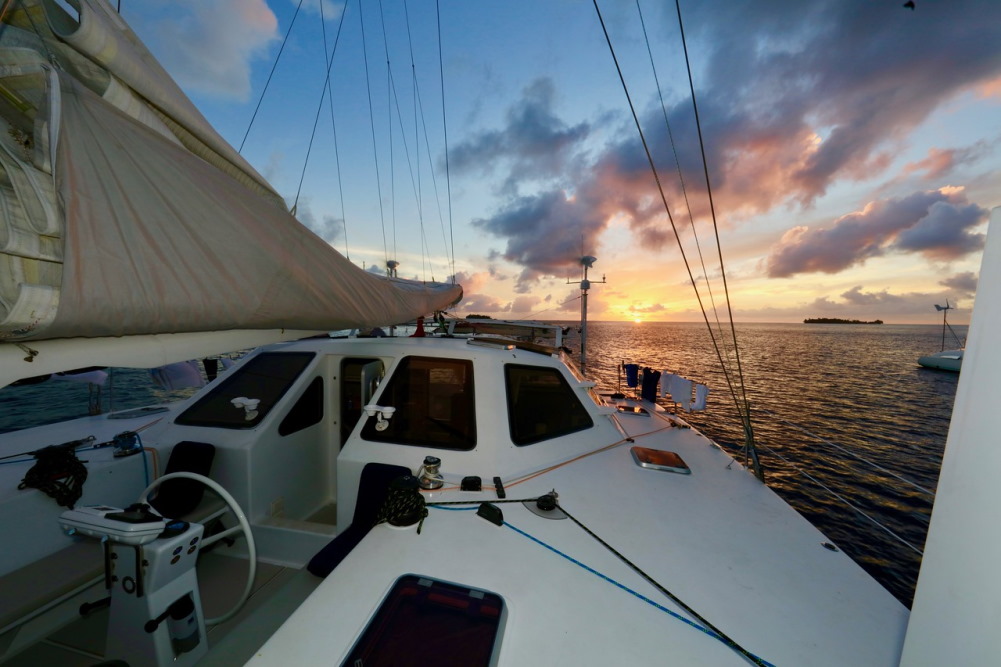
6. Forward Inside Helm
Pros:
Complete protection from elements, more comfort during adverse weather.
Centralised controls facilitate efficient single-handed sailing
Cons:
Limited feedback from sails and environment.
Potential for reduced visibility due to cabin structures.
Example: Kinetic KC54
The Kinetic’s forward inside helm merges luxury with performance, allowing sailors to helm from within the safety of the cabin. You can also opt for aft helms as a combo.
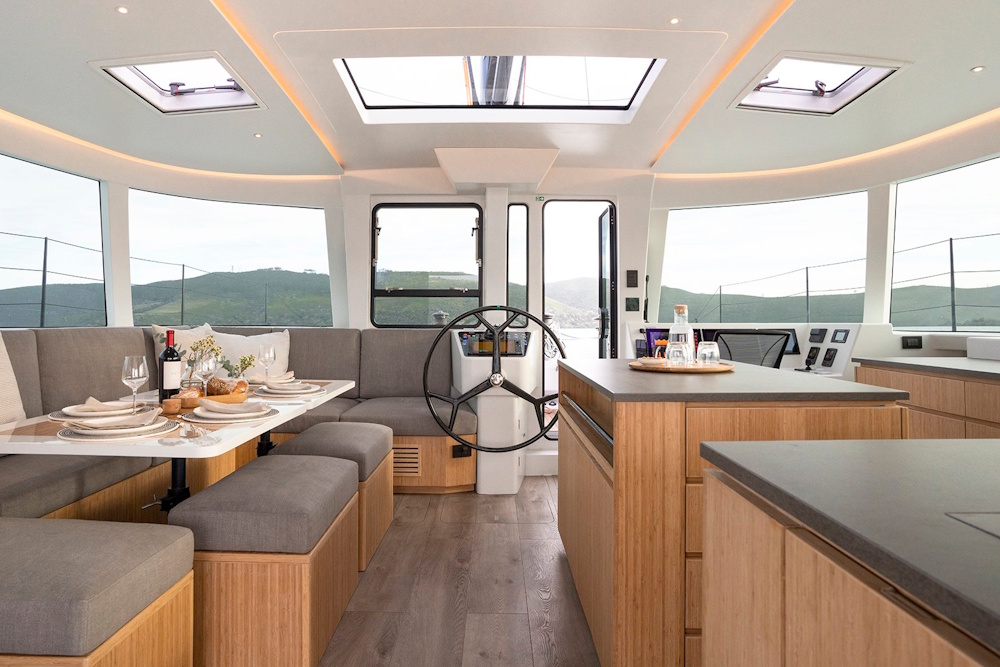
7. Forward Twin Helms
Pros:
Great forward visibility from both helms.
Balanced weight distribution contributes to performance and comfort.
Easy to anchor
Les complex rigging system, easier to raise and lower your sails.
Cons:
Exposure to elements without adequate shielding.
Increased complexity in design and equipment.
Takes up space in the living area up top.
Example: Windelo 54
The Windelo 54 incorporates forward twin helms: an innovative design with a focus on sustainability.
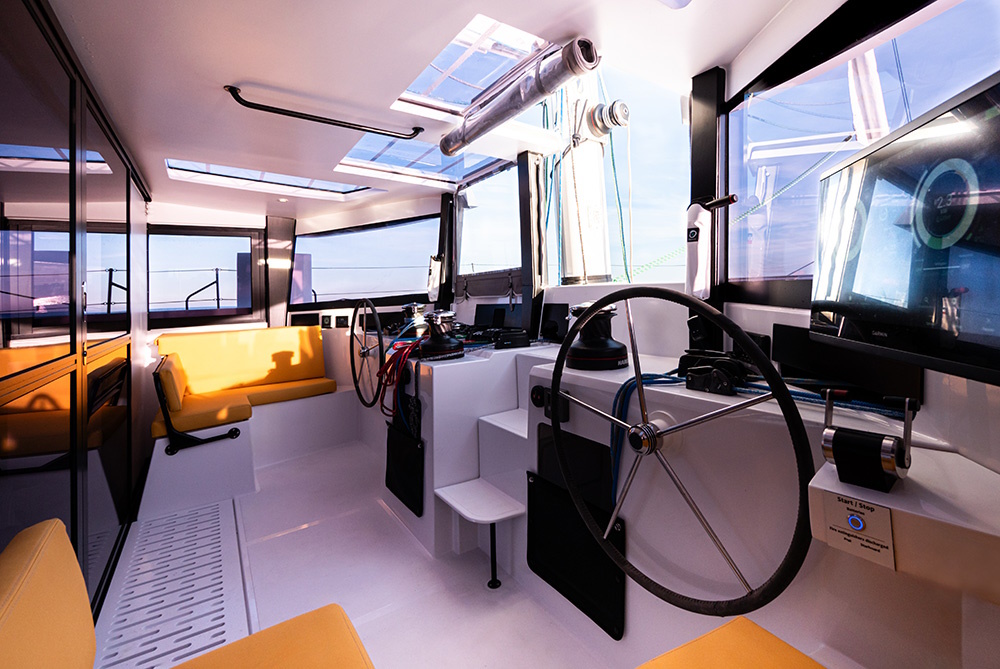
8. Swing Mid Helm
Pros:
Adjustable position offers flexibility based on the sailing conditions.
Combines benefits of protection and sailing feedback.
Cons:
More complex, less direct feedback from the rudders.
Not as easy to trim your sails on both tacks.
Examples: Outremer 55, Balance 526.
The Outremer 55 features a swing mid helm, allowing you to choose their preferred helm position.
Swing out for sailing feel, Swing vertical for docking, swing inboard for full protection.
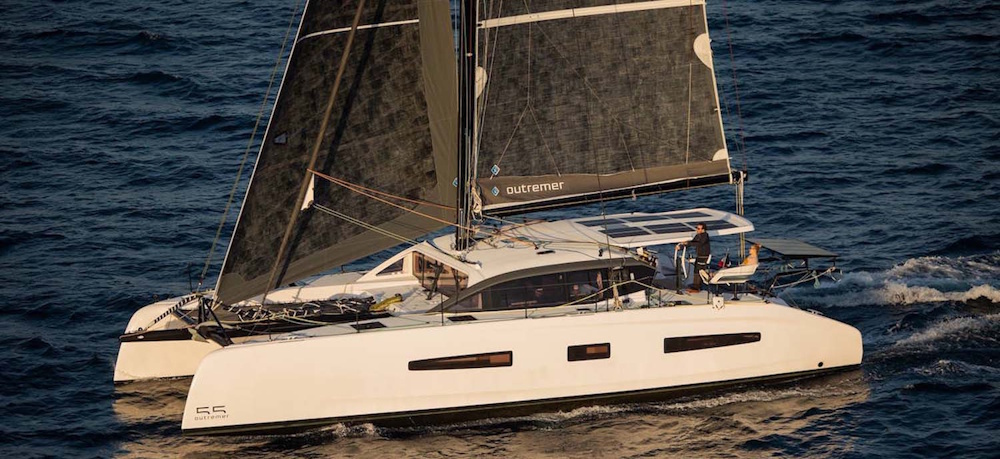
9. Swing Aft Helms
Pros:
Flexibility to adjust helm position for protection and visibility.
Aft location provides a better sailing experience.
Cons:
More complex system
Reduced visibility to the opposite bow, you’ll need to switch sides now and then.
Example: HH44
The HH44’s swing aft helms offer versatility, catering to various sailing preferences and conditions.
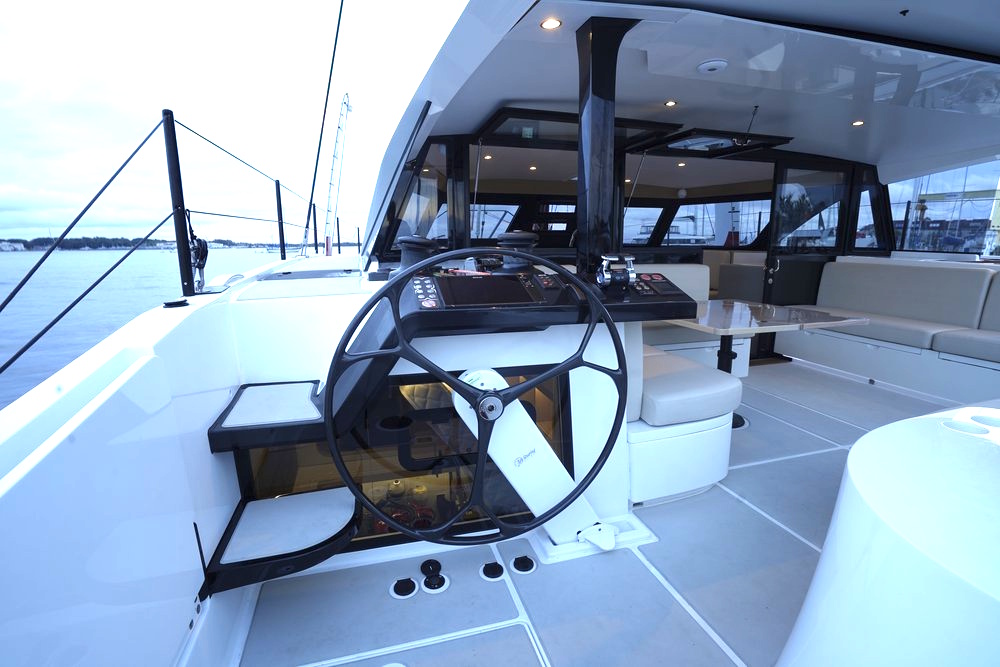
10. Aft Tillers
Pros:
The ultimate sailing feel – Direct rudder feedback gives the best helm responsiveness.
Lightweight & simple – No extra mechanical systems.
Cons:
Very exposed – little protection from the elements, which can be tough in bad weather.
Not ideal for long passages – Requires constant attention and physical effort.
Example: ORC 57, Outremer 5X
The ORC 57 and Outremer 5X both feature twin aft tillers, designed for performance-focused sailors who prioritize sailing feel over comfort. These helms provide direct connection to the rudders, making them ideal for those who love hands-on sailing.
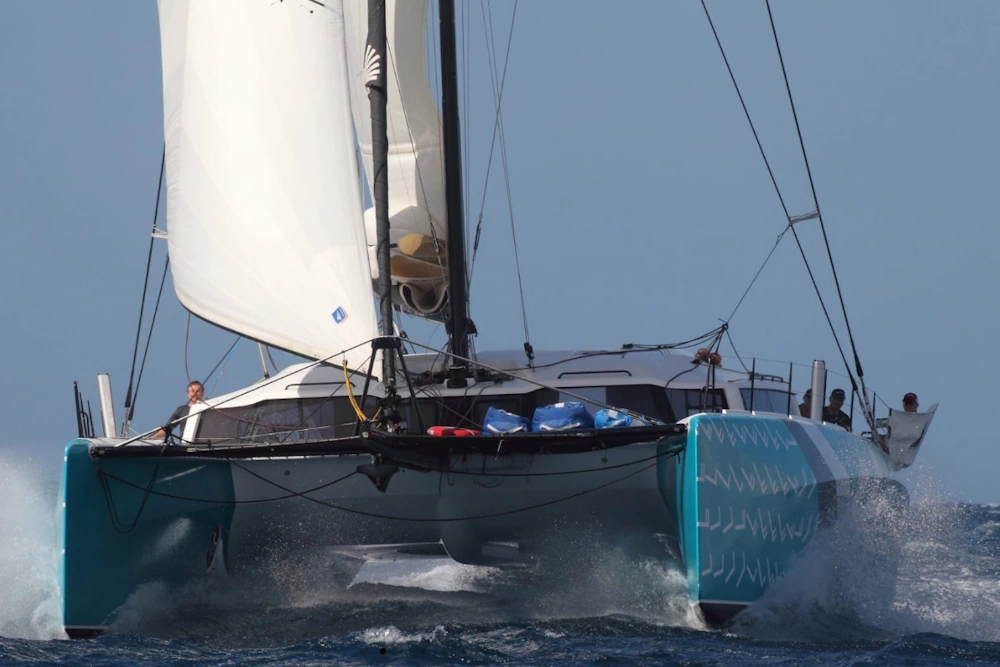
11. Single Flybridge Helm (e.g., Lagoon 60, Bali 5.4)
Pros:
Best visibility – The highest vantage point on the boat offers 360° views, ideal for navigation.
Spacious social area – The flybridge often includes seating and lounging space, making it a social hub.
You are right by the mast for raising and lowering sails, and putting in reefs.
Cons:
Far from the waterline – Less sailing feel and requires additional crew or electric winches for handling sails.
Exposed to the elements – Without a full enclosure, it can be more exposed in bad weather.
Disconnected from the rest of the crew down below.
Requires a higher boom, moving the centre of effort on the mainsail up.
Example: Lagoon 60
The Lagoon 60 places the helm on a central flybridge, providing commanding visibility while keeping the cockpit and salon free for guests. Ideal for comfort-focused cruisers.
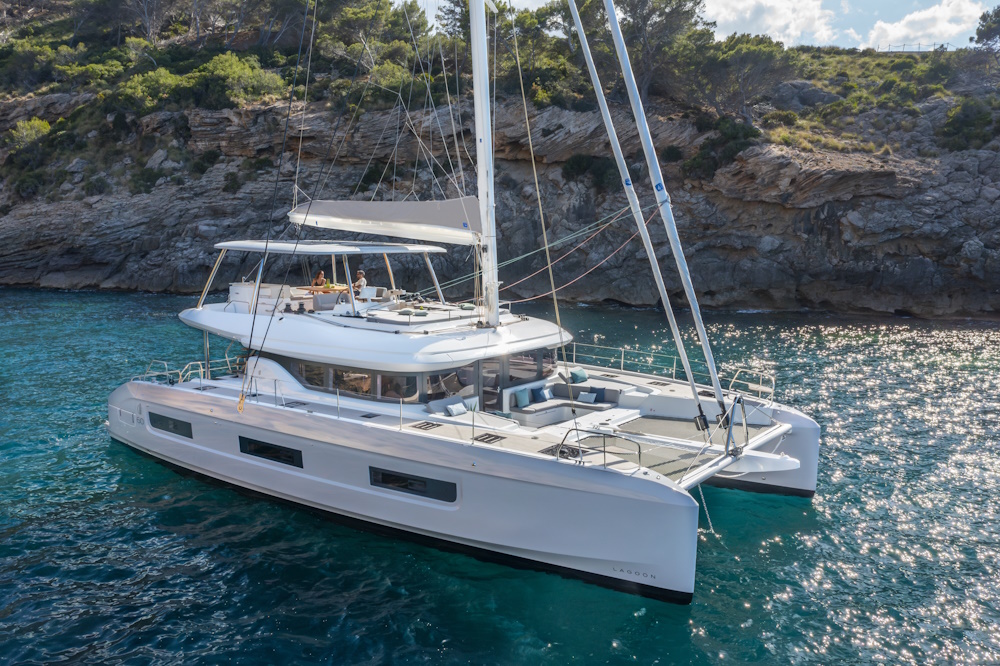
12. Twin Flybridge Helms (e.g., MC50, Sunreef 60)
Pros:
Flexible sailing positions – Having two helms on the flybridge allows you to choose the best side depending on wind and visibility.
Very social – with lounging areas, thi is where the party will be at anchor!
Cons:
Increased exposure – Higher elevation means more wind and sun exposure.
More complex and costly – Dual helm stations require extra hardware.
Disconnected from the crew down below
Example: McConaghy MC50
The McConaghy MC50 features twin flybridge helms, offering excellent visibility and easy sail handling, making it a popular choice for performance cruisers who also want comfort.
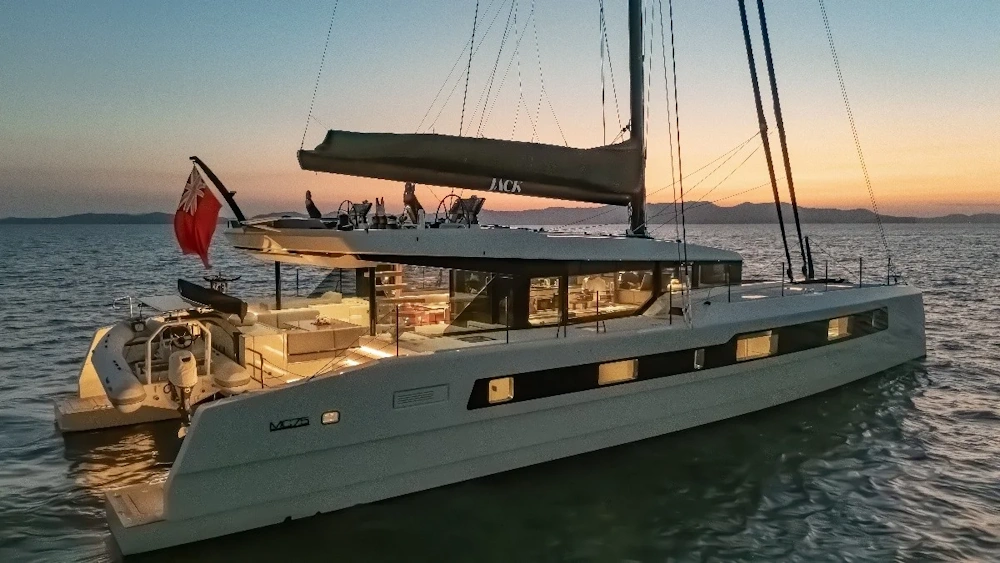
Summary – Which Helm Position is Best for You?
It is going to come down to your priorities.
Here’s a quick guide to match helm positions with different sailing styles:
For Maximum Comfort & Protection:
Inside forward helm, central mid helm, single flybridge helm
For Performance & Sailing Feel:
Twin aft helms, aft tillers, swing aft helms, twin swing mid-helms (Outremer), forward outside helm
For Balanced Comfort & Control:
Twin raised helms, twin flybridge helms, swing mid helm
For Easy Sail Handling & Visibility:
Single flybridge helm, twin flybridge helms, forward outside helm
For Social
The flybridge Helms
What is the Best Overall Helm Position?
This is only our view!
We vote for a hybrid solution with twin aft helms and an inside forward helm with a forward cockpit/working station.
We reckon this gives you the ultimate blend, the best of both worlds. Protection form the elements when you need it, and sailing feel aft. This set up will only really work on bigger boats though.
For smaller catamarans, we’d go for raised mid-helm or swing mid helms. We like the Seawind solution for more protection. Aft helms are the most fun.
Final Thoughts
Choosing the right helm position is about balancing visibility, sail handling, comfort, and sailing experience. Which helm position do YOU prefer? Let us know.
🔔 Subscribe to our YouTube channel for more sailing content!
